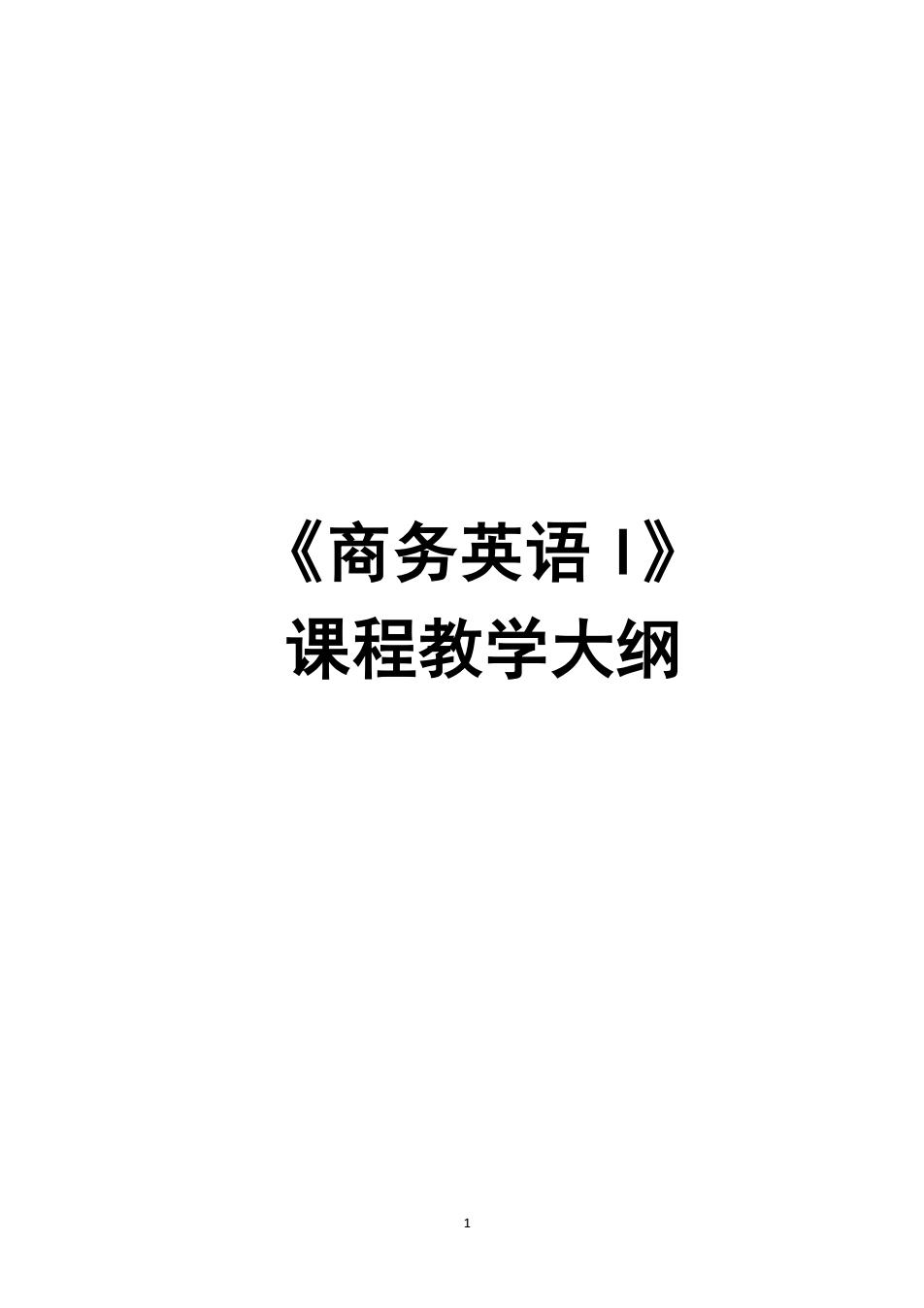
《商务英语I》 课程教学大纲
1 《商务英语 I》 课程教学大纲
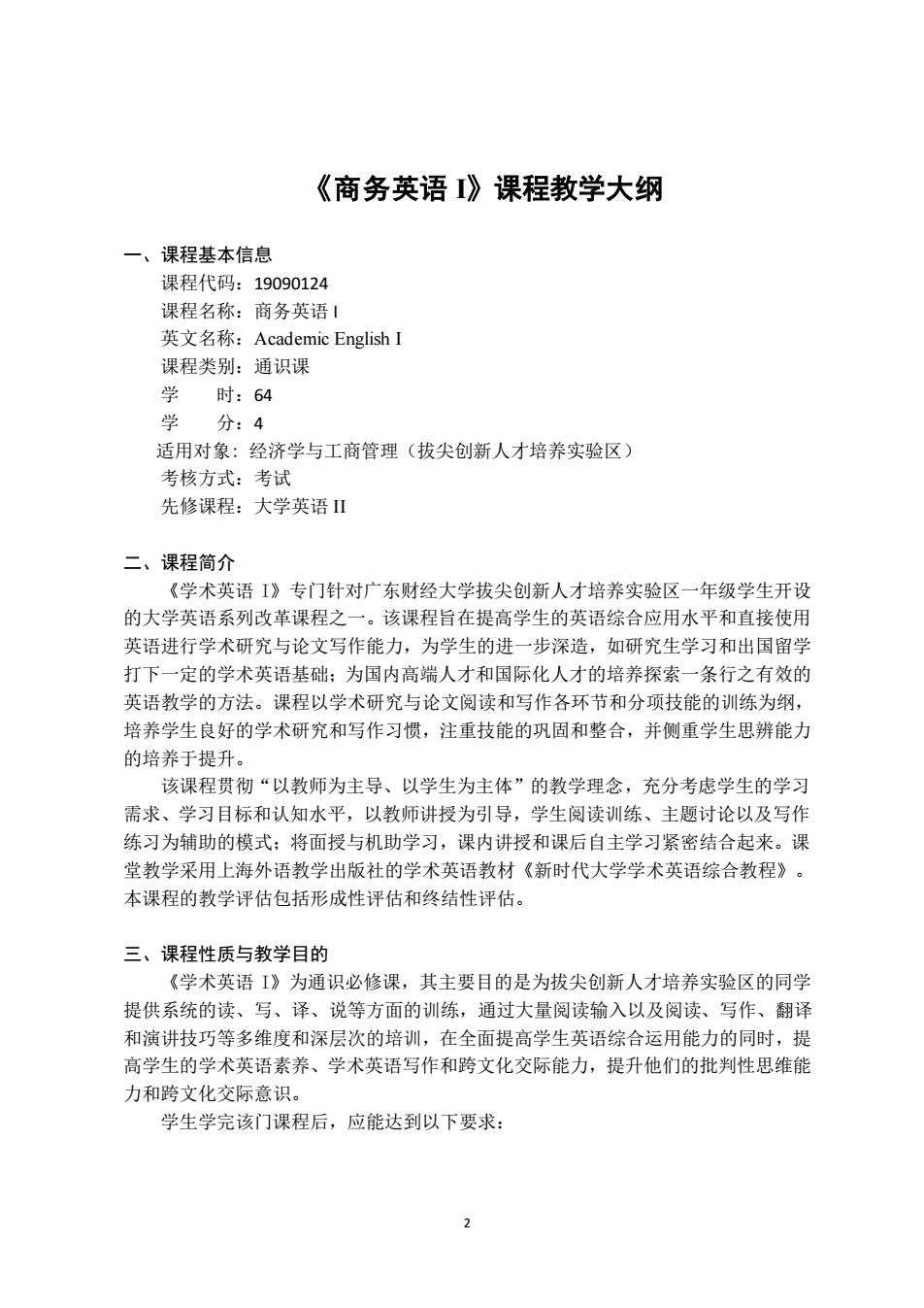
《商务英语》课程教学大纲 一、课程基本信息 课程代码:19090124 课程名称:商务英语! 英文名称:Academic English I 课程类别:通识课 时:64 学 分分:4 适用对象:经济学与工商管理(拔尖创新人才培养实验区) 考核方式:考试 先修课程:大学英语 二、课程简介 《学术英语[》专门针对广东财经大学拔尖创新人才培养实验区一年级学生开设 的大学英语系列改革课程之一。该课程旨在提高学生的英语综合应用水平和直接使用 英语进行学术研究与论文写作能力,为学生的进一步深造,如研究生学习和出国留学 打下一定的学术英语基础:为国内高端人才和国际化人才的培养探索一条行之有效的 英语教学的方法。课程以学术研究与论文阅读和写作各环节和分项技能的训练为纲, 培养学生良好的学术研究和写作习惯,注重技能的巩固和整合,并侧重学生思辨能力 的培养于提升。 该课程贯彻“以教师为主导、以学生为主体”的教学理念,充分考虑学生的学习 需求、学习目标和认知水平,以教师讲授为引导,学生阅读训练、主题讨论以及写作 练习为辅助的模式:将面授与机助学习,课内讲授和课后自主学习紧密结合起来。课 堂教学采用上海外语教学出版社的学术英语教材《新时代大学学术英语综合教程》 本课程的教学评估包括形成性评估和终结性评估。 三、课程性质与教学目的 《学术英语I》为通识必修课,其主要目的是为拔尖创新人才培养实验区的同学 提供系统的读、写、译、说等方面的训练,通过大量阅读输入以及阅读、写作、翻译 和演讲技巧等多维度和深层次的培训,在全面提高学生英语综合运用能力的同时,提 高学生的学术英语素养、学术英语写作和跨文化交际能力,提升他们的批判性思维能 力和跨文化交际意识。 学生学完该门课程后,应能达到以下要求: 2
2 《商务英语 I》课程教学大纲 一、课程基本信息 课程代码:19090124 课程名称:商务英语 I 英文名称:Academic English I 课程类别:通识课 学 时:64 学 分:4 适用对象: 经济学与工商管理(拔尖创新人才培养实验区) 考核方式:考试 先修课程:大学英语 II 二、课程简介 《学术英语 I》专门针对广东财经大学拔尖创新人才培养实验区一年级学生开设 的大学英语系列改革课程之一。该课程旨在提高学生的英语综合应用水平和直接使用 英语进行学术研究与论文写作能力,为学生的进一步深造,如研究生学习和出国留学 打下一定的学术英语基础;为国内高端人才和国际化人才的培养探索一条行之有效的 英语教学的方法。课程以学术研究与论文阅读和写作各环节和分项技能的训练为纲, 培养学生良好的学术研究和写作习惯,注重技能的巩固和整合,并侧重学生思辨能力 的培养于提升。 该课程贯彻“以教师为主导、以学生为主体”的教学理念,充分考虑学生的学习 需求、学习目标和认知水平,以教师讲授为引导,学生阅读训练、主题讨论以及写作 练习为辅助的模式;将面授与机助学习,课内讲授和课后自主学习紧密结合起来。课 堂教学采用上海外语教学出版社的学术英语教材《新时代大学学术英语综合教程》。 本课程的教学评估包括形成性评估和终结性评估。 三、课程性质与教学目的 《学术英语 I》为通识必修课,其主要目的是为拔尖创新人才培养实验区的同学 提供系统的读、写、译、说等方面的训练,通过大量阅读输入以及阅读、写作、翻译 和演讲技巧等多维度和深层次的培训,在全面提高学生英语综合运用能力的同时,提 高学生的学术英语素养、学术英语写作和跨文化交际能力,提升他们的批判性思维能 力和跨文化交际意识。 学生学完该门课程后,应能达到以下要求:
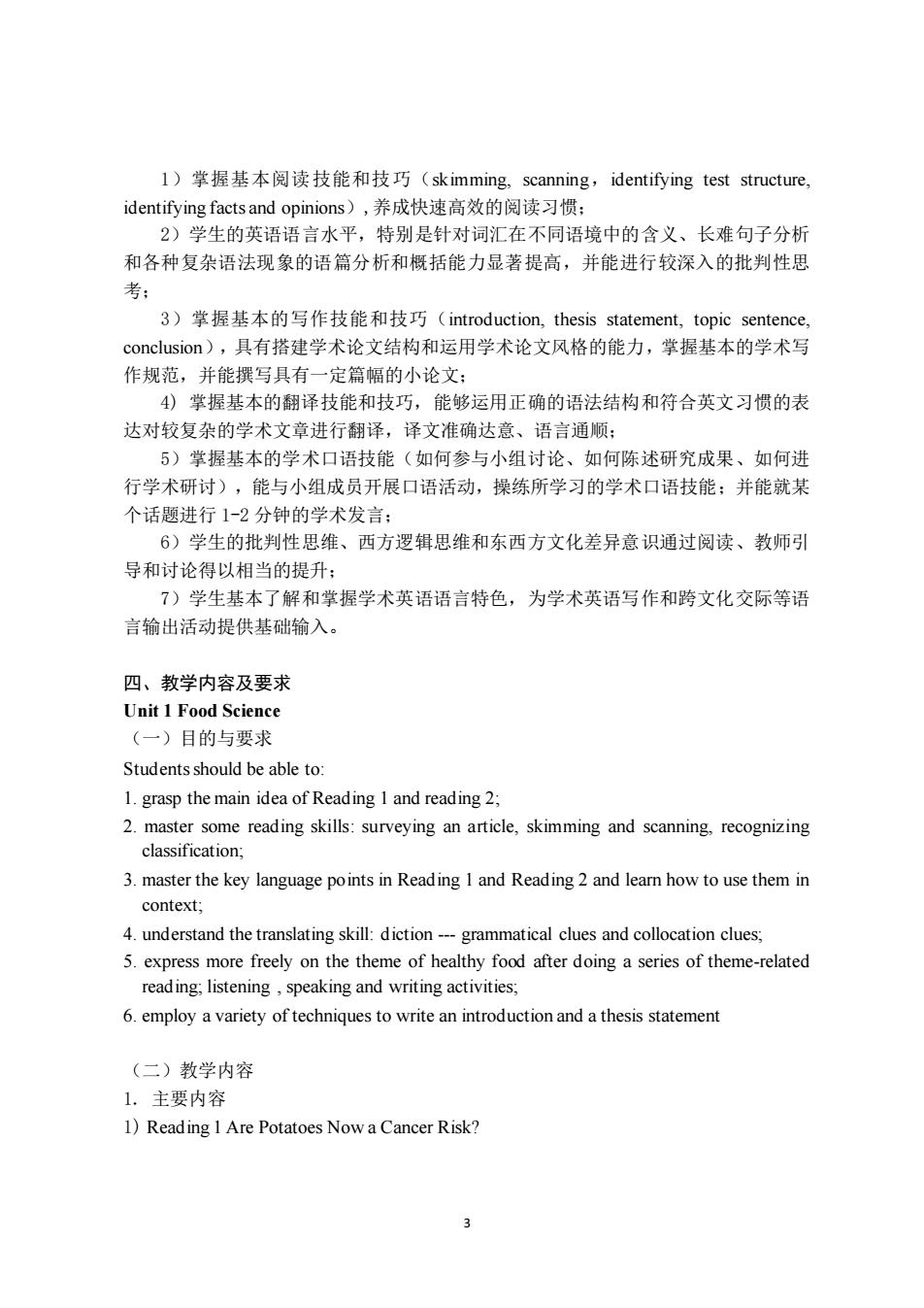
1)掌握基本阅读技能和技巧(skimming,scanning,identifying test structure. identifying factsand opinions),养成快速高效的阅读习惯: 2)学生的英语语言水平,特别是针对词汇在不同语境中的含义、长难句子分析 和各种复杂语法现象的语篇分析和概括能力显著提高,并能进行较深入的批判性思 3)掌握基本的写作技能和技巧(introduction,thesis statement,.topic sentence, conclusion),具有搭建学术论文结构和运用学术论文风格的能力,掌握基本的学术写 作规范,并能撰写具有一定篇幅的小论文: 4)掌握基本的翻译技能和技巧,能够运用正确的语法结构和符合英文习惯的表 达对较复杂的学术文章进行翻译,译文准确达意、语言通顺: 5)掌握基本的学术口语技能(如何参与小组讨论、如何陈述研究成果、如何进 行学术研讨),能与小组成员开展口语活动,操练所学习的学术口语技能:并能就某 个话题进行1-2分钟的学术发言: 6)学生的批判性思维、西方逻辑思维和东西方文化差异意识通过阅读、教师引 导和讨论得以相当的提升: 7)学生基本了解和堂握学术英语语言特色,为学术英语写作和跨文化交际等语 言输出活动提供基础输入。 四、教学内容及要求 Unit 1 Food Science (一)目的与要求 Students should be able to: 1.grasp the main idea of Reading I and reading 2, 2.master some reading skills:surveying an article,skimming and scanning.recognizing classification, 3.master the key language points in Reading 1 and Reading 2 and leam how to use them in context; 4.understand the translating skill:diction-grammatical clues and collocation clues: 5.express more freely on the theme of healthy food after doing a series of theme-related reading;listening,speaking and writing activities; 6.employ a variety of techniques to write an introduction and a thesis statement (二)教学内容 1.主要内容 1)Reading I Are Potatoes Now a Cancer Risk? 3
3 1)掌握基本阅读技能和技巧(skimming, scanning,identifying test structure, identifying facts and opinions),养成快速高效的阅读习惯; 2)学生的英语语言水平,特别是针对词汇在不同语境中的含义、长难句子分析 和各种复杂语法现象的语篇分析和概括能力显著提高,并能进行较深入的批判性思 考; 3)掌握基本的写作技能和技巧(introduction, thesis statement, topic sentence, conclusion),具有搭建学术论文结构和运用学术论文风格的能力,掌握基本的学术写 作规范,并能撰写具有一定篇幅的小论文; 4) 掌握基本的翻译技能和技巧,能够运用正确的语法结构和符合英文习惯的表 达对较复杂的学术文章进行翻译,译文准确达意、语言通顺; 5)掌握基本的学术口语技能(如何参与小组讨论、如何陈述研究成果、如何进 行学术研讨),能与小组成员开展口语活动,操练所学习的学术口语技能;并能就某 个话题进行 1-2 分钟的学术发言; 6)学生的批判性思维、西方逻辑思维和东西方文化差异意识通过阅读、教师引 导和讨论得以相当的提升; 7)学生基本了解和掌握学术英语语言特色,为学术英语写作和跨文化交际等语 言输出活动提供基础输入。 四、教学内容及要求 Unit 1 Food Science (一)目的与要求 Students should be able to: 1. grasp the main idea of Reading 1 and reading 2; 2. master some reading skills: surveying an article, skimming and scanning, recognizing classification; 3. master the key language points in Reading 1 and Reading 2 and learn how to use them in context; 4. understand the translating skill: diction --- grammatical clues and collocation clues; 5. express more freely on the theme of healthy food after doing a series of theme-related reading; listening , speaking and writing activities; 6. employ a variety of techniques to write an introduction and a thesis statement (二)教学内容 1. 主要内容 1) Reading 1 Are Potatoes Now a Cancer Risk?
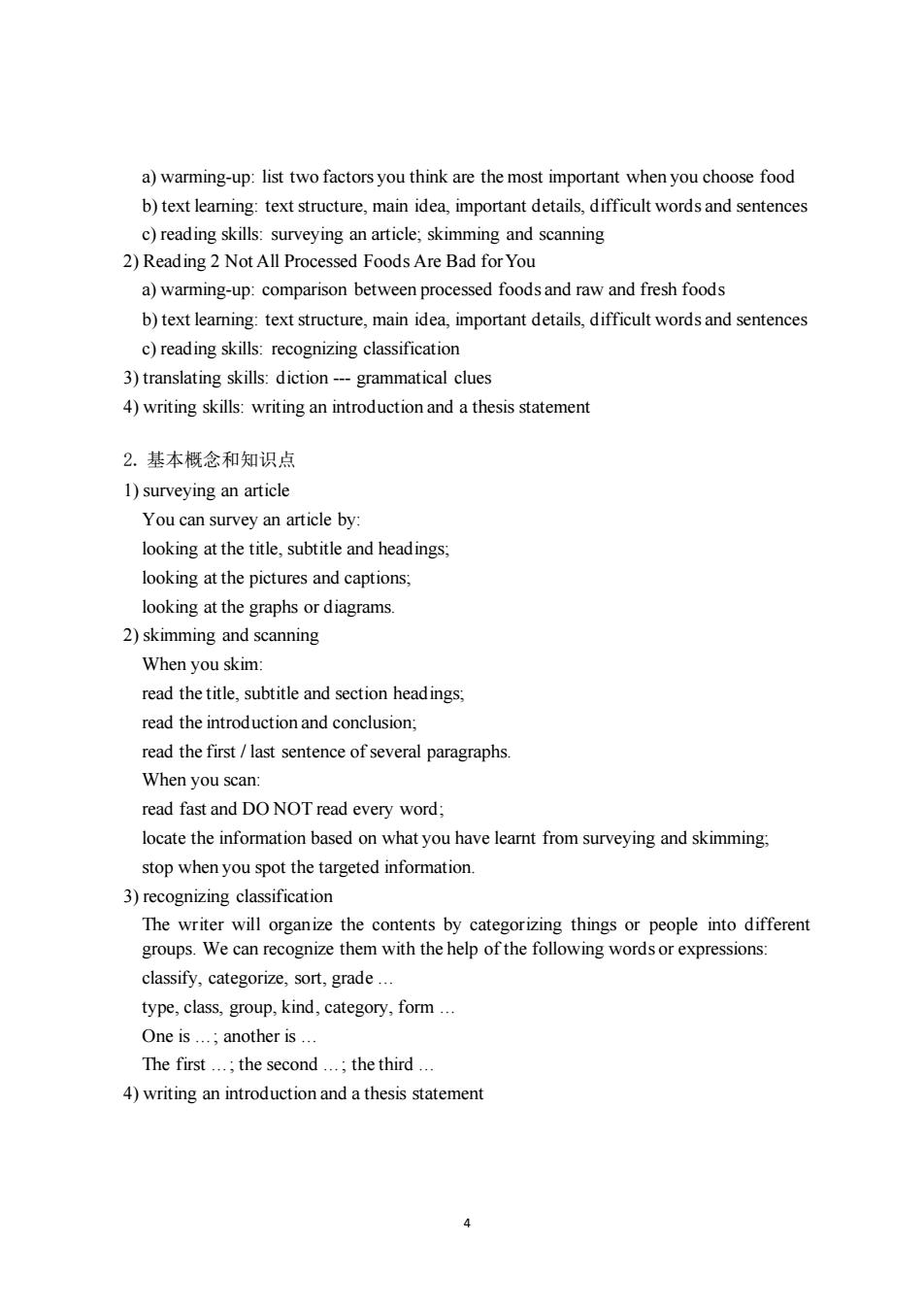
a)warming-up:list two factors you think are the most important when you choose food b)text leaming:text structure,main idea,important details,difficult words and sentences c)reading skills:surveying an article;skimming and scanning 2)Reading 2 NotAll Processed Foods Are Bad for You a)warming-up:comparison between processed foods and raw and fresh foods b)text leaming:text structure,main idea,important details,difficult words and sentences c)reading skills:recognizing classification 3)translating skills:diction--grammatical clues 4)writing skills:writing an introduction and a thesis statement 2.基本概念和知识点 1)surveying an article You can survey an article by: looking at the title,subtitle and headings looking at the pictures and captions; looking at the graphs or diagrams 2)skimming and scanning When you skim: read the title,subtitle and section headings read the introduction and conclusion; read the first/last sentence of several paragraphs When you scan read fast and DO NOT read every word: locate the information based on what you have leamt from surveying and skimming stop when you spot the targeted information. 3)recognizing classification The writer will organize the contents by categorizing things or people into different groups.We can recognize them with the help of the following words or expressions classify,categorize,sort,grade.. type,class,group,kind,category,form... One is..;another is The first...:the second...:the third... 4)writing an introduction and a thesis statement
4 a) warming-up: list two factors you think are the most important when you choose food b) text learning: text structure, main idea, important details, difficult words and sentences c) reading skills: surveying an article; skimming and scanning 2) Reading 2 Not All Processed Foods Are Bad for You a) warming-up: comparison between processed foods and raw and fresh foods b) text learning: text structure, main idea, important details, difficult words and sentences c) reading skills: recognizing classification 3) translating skills: diction --- grammatical clues 4) writing skills: writing an introduction and a thesis statement 2. 基本概念和知识点 1) surveying an article You can survey an article by: looking at the title, subtitle and headings; looking at the pictures and captions; looking at the graphs or diagrams. 2) skimming and scanning When you skim: read the title, subtitle and section headings; read the introduction and conclusion; read the first / last sentence of several paragraphs. When you scan: read fast and DO NOT read every word; locate the information based on what you have learnt from surveying and skimming; stop when you spot the targeted information. 3) recognizing classification The writer will organize the contents by categorizing things or people into different groups. We can recognize them with the help of the following words or expressions: classify, categorize, sort, grade … type, class, group, kind, category, form … One is …; another is … The first …; the second …; the third … 4) writing an introduction and a thesis statement
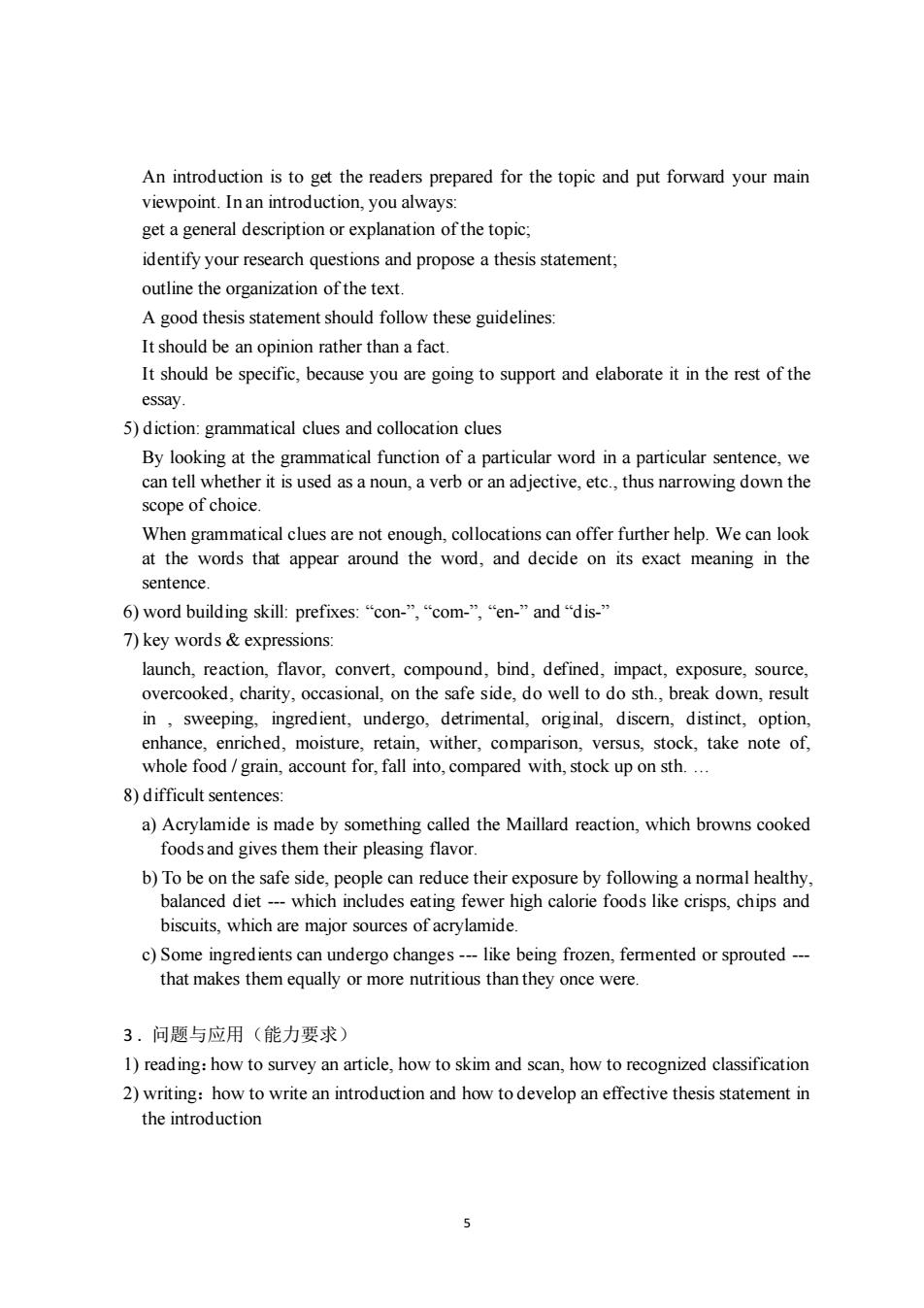
An introduction is to get the readers prepared for the topic and put forward your main viewpoint.Inan introduction,you always: get a general description or explanation of the topic, identify your research questions and propose a thesis statement. outline the organization of the text. A good thesis statement should follow these guidelines It should be an opinion rather than a fact. It should be specific,because you are going to support and elaborate it in the rest of the essav 5)diction:grammatical clues and collocation clues By looking at the grammatical function of a particular word in a particular sentence,we can tell whether it is usd asaoua verbor or an adjective,etc.,thus narrowing down the When grammatical clues are not enough,collocations can offer further help.We can look at the words that appear around the word,and decide on its exact meaning in the sentence. 6)word building skill:prefixes:“con-”,“com-”,“en-”and"dis-” 7)key words&expressions launch,reaction,flavor,convert,compound,bind,defined,impact,exposure,source overcooked,charity,occasional,on the safe side. do well to do sth.break down.resul in,sweeping,ingredient,undergo,detrimental,original,discemn,distinct,option, enhance,enriched,moisture,retain,wither,comparison,versus,stock,take note of, whole food/grain,account for,fall into,compared with,stock up on sth. 8)difficult sentences: a)Acrylamide is made by something called the Maillard reaction,which browns cooked foods and gives them their pleasing flavo b)To be on the safe side.people can reduce their exposure by following a normal healthy balanced diet-which includes eating fewer high calorie foods like crisps,chips and biscuits,which are major sources of acrylamide. c)Some ingredients can undergo changes---like being frozen,fermented or sprouted- that makes them equally or more nutritious than they once were. 3.问题与应用(能力要求) 1)reading:how to survey an article,how to skim and scan,how to recognized classification 2)writing:how to write an introduction and how to develop an effective thesis statement in the introduction
5 An introduction is to get the readers prepared for the topic and put forward your main viewpoint. In an introduction, you always: get a general description or explanation of the topic; identify your research questions and propose a thesis statement; outline the organization of the text. A good thesis statement should follow these guidelines: It should be an opinion rather than a fact. It should be specific, because you are going to support and elaborate it in the rest of the essay. 5) diction: grammatical clues and collocation clues By looking at the grammatical function of a particular word in a particular sentence, we can tell whether it is used as a noun, a verb or an adjective, etc., thus narrowing down the scope of choice. When grammatical clues are not enough, collocations can offer further help. We can look at the words that appear around the word, and decide on its exact meaning in the sentence. 6) word building skill: prefixes: “con-”, “com-”, “en-” and “dis-” 7) key words & expressions: launch, reaction, flavor, convert, compound, bind, defined, impact, exposure, source, overcooked, charity, occasional, on the safe side, do well to do sth., break down, result in , sweeping, ingredient, undergo, detrimental, original, discern, distinct, option, enhance, enriched, moisture, retain, wither, comparison, versus, stock, take note of, whole food / grain, account for, fall into, compared with, stock up on sth. … 8) difficult sentences: a) Acrylamide is made by something called the Maillard reaction, which browns cooked foods and gives them their pleasing flavor. b) To be on the safe side, people can reduce their exposure by following a normal healthy, balanced diet --- which includes eating fewer high calorie foods like crisps, chips and biscuits, which are major sources of acrylamide. c) Some ingredients can undergo changes --- like being frozen, fermented or sprouted --- that makes them equally or more nutritious than they once were. 3 . 问题与应用(能力要求) 1) reading:how to survey an article, how to skim and scan, how to recognized classification 2) writing:how to write an introduction and how to develop an effective thesis statement in the introduction